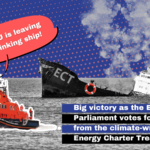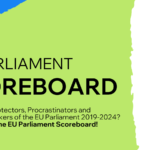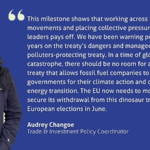All eyes will be on the EU Finance Ministers meeting in Brussels on November 10th to adopt the EU position on climate finance for the Paris climate summit. According to Climate Action Network (CAN) Europe, their commitment to deliver the EU’s fair share of $100 billion of climate finance annually by 2020 and to consistently scale it up after 2020 can be the make or break issue for the Paris climate agreement.
Poor countries call on the EU and other developed countries for scaling up financial support after 2020, with the goal of $100 billion annually in 2020 used as a starting point. They also advocate for setting five-year cycles of support, which will provide more predictability and thus allow them to plan for most effective and timely use of the funds. So far the developed countries have provided no assurances that financial support will be consistently scaled up after 2020, reflecting the growing needs of developing countries.
EU finance ministers need to fill the enormous void on climate finance in the negotiations – Wendel Trio, Director of CAN Europe said. EU leaders’ silence on climate finance after 2020 stands in sharp contrast to their push for countries to submit emission reduction pledges. Empowering the world’s poor to cope with the impacts of climate change and grow in a less polluting way, is a precondition to getting them to sign the agreement in Paris. It would also help convince them to chip in climate finance after 2020, which is much needed in order to ensure a global scale of climate action.
Reaching the $100 billion goal
The chance of a successful Paris climate deal depends on developed countries keeping their past commitments, namely the promise to jointly mobilize $100 billion of climate financing per year by 2020. While there has been progress made towards reaching this goal, there is still a long way to go. The EU finance ministers need to provide a concrete roadmap that spells out plans of the Member States to reach the climate finance target of $100 billion dollars annually by 2020, including sources of the funds and channels to deploy them.
A recent study by the OECD [1] estimates that $62 billion have been mobilized in 2014. This figure is misleading for a number of reasons. Firstly, much of the finance is made up of loans, including non-concessional loans, which need to be repaid over time. Secondly, it includes funding that only partially addresses climate change. Thirdly, most of the public climate finance comes from existing, often stagnant, flows of development aid. The funds committed to date are a step forward, but a clear and commonly agreed definition of what comprises climate finance should be part of the Paris agreement.
Finance for adaptation
Even if global warming is kept to 2 degrees Celsius, the costs of adapting to climate change in the developing countries could climb as high as $500 billion per year by 2050 [2]. Yet, only 16% of climate finance went to adaptation in 2013-14. So far the EU has made no concrete commitment to balance funding for adaptation and mitigation. The EU finance ministers need to put more on the table for the people on the frontlines of climate change, through a specific goal of public finance for adaptation and a 50-50 balance between funding for climate adaptation and mitigation.
Innovative sources of finance
In order to cover the growing needs for climate finance in developing countries, while not diverting money from over-stretched development aid budgets, donor countries need to mobilise innovative sources of public finance. This will give a strong signal to developing country partners that public climate finance will continue to increase, beyond aid budgets, and thus smooth the path towards a new climate deal in Paris.
The EU ETS is currently being revised for the 2021-2030 period, providing a key opportunity for the EU to direct a portion of the revenues from auctioning directly into the Green Climate Fund. This could potentially triple EU contributions to the Fund. EU finance ministers need to tap into potential sources of climate finance, including ETS revenues, as well as the Financial Transaction Tax or fuel levies on international transport.
Reverse the flows
Developed countries are still spending billions of euros on funding fossil fuel industries. The EU has spent six times as much on subsidizing fossil fuels as it has on climate finance [3]. The Paris agreement should stimulate the shift in investments away from dirty energy, e.g. by providing impetus to a phase out of all fossil fuel subsidies. Instead, countries need to increase financial flows and investments for renewable energy, energy efficiency and climate change adaptation.
The EU leaders need to walk the talk on shifting financial flows and investing in ‘green’, by a clear commitment to stop using EU public finance for dirty energy projects abroad. The EU finance ministers need to commit to ending all public financing for coal projects, except in extreme cases where there is clearly no other viable option for increasing energy access to the poor.
Footnotes:
[1] OECD, Climate Finance in 2013-14 and the USD 100 billion goal, October 2015,
http://www.oecd.org/environment/cc/oecd-cpi-climate-finance-report.htm
[2] UNEP, Global Adaptation Gap Report 2014, December 2014,
http://www.unep.org/newscentre/Default.aspx?DocumentID=2814&ArticleID=11097&l=en
[3] CAN Europe, Briefing ‘Reverse the flows: G20 countries should stop funding the causes of climate change and increase support for real solutions’, September 2015, https://caneurope.org/docman/position-papers-and-research/climate-finance-and-development/2682-reverse-the-flows-briefing-climate-finance/file
More information:
CAN Europe, Letter to EU Finance Ministers ahead of the ECOFIN Council on 10th November 2015, October 2015, https://caneurope.org/docman/position-papers-and-research/climate-finance-and-development/2763-can-europe-letter-to-finance-ministers/file
WWF, EU climate finance briefing, October 2015, http://d2ouvy59p0dg6k.cloudfront.net/downloads/wwf_eu_climate_finance_briefing___final.pdf
Oxfam, The right to resilience, Briefing on adaptation finance in the post-2020 Paris agreement, June 2015, https://www.oxfam.org/sites/www.oxfam.org/files/file_attachments/right_to_resilience_-_adaptation_finance_in_the_post-2020_paris_agreement.pdf
Oxfam, The EU’S emission trading scheme as a source of international climate finance, June 2015, https://www.oxfam.org/sites/www.oxfam.org/files/file_attachments/the_eus_emission_trading_scheme_as_a_source_of_international_climate_finance_.pdf
Oxfam, Behind the numbers: Getting to $100 billion in climate finance, October 2015, http://politicsofpoverty.oxfamamerica.org/2015/10/behind-the-numbers-getting-to-100-billion-in-climate-finance/
Oxfam, OECD report on climate finance: Fit for purpose or well on the way to meet the $100 billion promise?, October 2015,
http://www.germanclimatefinance.de/2015/10/08/well-way-meet-100-billion-promise/
CAN International, Position on a finance package for Paris, June 2015, https://caneurope.org/docman/position-papers-and-research/climate-finance-and-development/2647-can-position-climate-finance-package-for-paris-june-2015/file
Important events related to climate finance:
November 8 – 10th, pre-COP
November 10th, ECOFIN Council finalizing the EU’s position for COP21, reactive statement by CAN Europe, Oxfam and WWF
November 12th, Oil Change International and Overseas Development Institute, report on fossil fuels production subsidies in G20 countries
November 14th, Stop Funding Fossils Day of Action
November 15-16th, G20 Summit
November 24th, CAN Europe pre-COP press briefing (date TBC)
November 30th – December 1st, Competitiveness Council discussing review of the EU ETS
November 30th – December 11th, COP21 in Paris
December 16th, Environment Council
December 17th – 18th, European Council
Contact:
Ania Drazkiewicz, CAN Europe, ania@caneurope.org, 00 32 494 52 57 38
Climate Action Network (CAN) Europe is Europe’s largest coalition working on climate and energy issues. With over 120 member organisations in more than 30 European countries – representing over 44 million citizens – CAN Europe works to prevent dangerous climate change and promote sustainable climate and energy policy in Europe.



